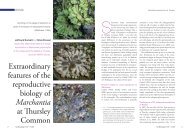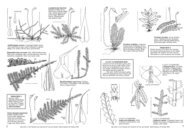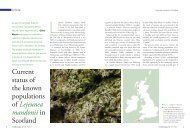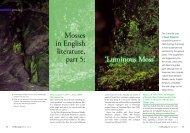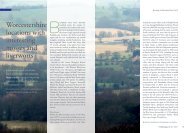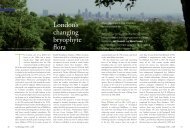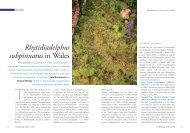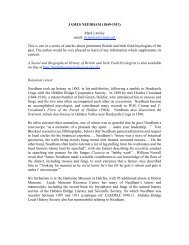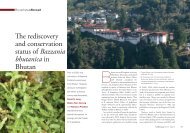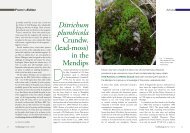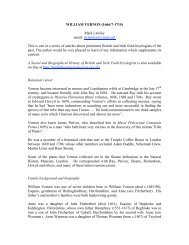Armitage, Eleonora - Royal Botanic Garden Edinburgh
Armitage, Eleonora - Royal Botanic Garden Edinburgh
Armitage, Eleonora - Royal Botanic Garden Edinburgh
You also want an ePaper? Increase the reach of your titles
YUMPU automatically turns print PDFs into web optimized ePapers that Google loves.
ELEONORA ARMITAGE (1865-1961)<br />
Mark Lawley<br />
12A Castleview Terrace, Ludlow, SY8 2NG<br />
email: m.lawley@virgin.net<br />
This article is one in a series about prominent British and Irish field-bryologists of the<br />
past. The author would be very pleased to learn of any information which supplements its<br />
content.<br />
A Social and Biographical History of British and Irish Field-bryologists is also available<br />
on-line at http://britishbryologicalsociety.org.uk/<br />
Bryological career<br />
<strong>Eleonora</strong> <strong>Armitage</strong> was a keen and accomplished field-bryologist, and the only female<br />
founding member of the Moss Exchange Club in 1896. After Augustin Ley died in 1911,<br />
Miss <strong>Armitage</strong> was indisputably the botanical matriarch of her home county of<br />
Herefordshire, and enjoyed contacts with many of the leading botanists of the day. She<br />
made numerous notable discoveries in Herefordshire, and wrote papers on the shire’s<br />
Sphagnum mosses in 1923 and liverworts in 1925. She found the rare moss Anomodon<br />
longifolius near Huntsham Hill in south Herefordshire. Stimulated by the publication of<br />
MacVicar’s guide to liverworts in 1912 she found Apometzgeria pubescens on Huntsham<br />
Hill, Blepharostoma trichophyllum and Scapania gracilis in Chase Wood near Ross, and<br />
elsewhere (these species are rare in Herefordshire), Cephaloziella turneri in Haugh Wood<br />
and Titley, Harpanthus scutatus from Penyard Wood near Ross, Scapania aspera at the<br />
Great Doward, Cololejeunea rossettiana on the Great Doward and Backbury Hill near<br />
Mordiford, Marchesinia mackaii at the Great Doward, Sphaerocarpos michelii from Foy<br />
and S. texanus from Foy, Bridstow, Walford and Weston-under-Penyard, and Anthoceros<br />
agrestis and Phaeoceros laevis in fields about Ross and near Bodenham. Henry Knight<br />
(see Field Bryology 83:18-21) often accompanied her on botanical excursions after he<br />
came to live in the neighbouring county of Gloucestershire.<br />
Miss <strong>Armitage</strong> became President of the British Bryological Society in 1939.<br />
Her plants are at the universities of Bristol and Manchester, with more than 700 other<br />
specimens at the National Museum of Wales in Cardiff. These include gatherings sent to<br />
her by A.R. Horwood, D.A. Jones, H.H. Knight, L.B.C. Trotter, J.A. Wheldon and others.<br />
Family background<br />
<strong>Eleonora</strong> <strong>Armitage</strong> was the fifth surviving child of eight born to Arthur <strong>Armitage</strong> (1812-<br />
1892) and Isabel Jane (née Perceval, 1830-1921). <strong>Eleonora</strong>’s siblings were Arthur (who<br />
died at birth on Christmas Day, 1851), Lucy (1852-1941), Isabel Jane (1855-1941, who
ecame sister-in-charge of surgery at St. Bartholomew’s Hospital), Robert (1857-1954,<br />
who entered the priesthood and served as chaplain in the armed forces until the age of 55,<br />
gaining a D.S.O. in the Boer War, and subsequently becoming vicar of Stanton Lacy near<br />
Ludlow from 1922 until 1945), Ernest (1860-1940), then <strong>Eleonora</strong> herself, followed by<br />
Cecilia (1870-1959), Frank (1872-1955, who joined the Indian police, and whose son<br />
Robert Perceval <strong>Armitage</strong>, 1906-1990, became colonial governor of India), and Arthur<br />
Haistwell <strong>Armitage</strong>, OBE, (born 1873).<br />
The family home was Dadnor, Bridstow, near Ross-on-Wye, Herefordshire, and <strong>Eleonora</strong><br />
(who did not marry) continued to live there with her younger sister Cecilia for many<br />
years after her parents had died, vacating only when the infirmities of old age compelled<br />
them to move to smaller premises nearby.<br />
Her father, Arthur, like his own father, was a practising barrister and Receiver of the<br />
Herefordshire estates of Guy’s Hospital, London, as well as a landed proprietor and<br />
farmer of 400 acres. Latterly he was a Justice of the Peace and Deputy Lieutenant. He<br />
was born at Burton Court, Linton, near Ross, the twelfth child of fourteen born to Whaley<br />
<strong>Armitage</strong> (1767-1855), barrister, and <strong>Eleonora</strong> (née Haistwell, 1775-1838). <strong>Eleonora</strong><br />
Haistwell’s parents were Edward (1736-1783, of Kensington, London) and <strong>Eleonora</strong> (née<br />
Brickenden, 1749-1820, of Inkpen, Berkshire). Edward Haistwell’s paternal grandfather,<br />
also Edward (c.1658-1709, see Dictionary of National Biography) was a Quaker<br />
merchant who became prominent in the early years of the Society of Friends. However,<br />
his son did not remain a Quaker.<br />
Whaley <strong>Armitage</strong> was a son of Robert <strong>Armitage</strong> (1727-1787) of Kensington, London,<br />
who was born in and became a merchant of Liverpool, and Caroline (née Braithwaite,<br />
1734-1802), daughter of John Braithwaite (1696-1740), a soldier and diplomatist of<br />
sufficient prominence to merit an entry in the Dictionary of National Biography. These<br />
Braithwaites, like the Haistwells, came from Westmorland. The <strong>Armitage</strong>s had<br />
connections with Ireland, and the name of Whaley stems from Richard Chappell (or<br />
Chapel) Whaley (c.1700-1769) of Whaley Abbey, MP for Co. Wicklow, who married<br />
Catherine, daughter of Robert Braithwaite. Their second daughter, Anne, married John<br />
Fitzgibbon, Lord Clare, 1 st Earl and Lord High Chancellor of Ireland. Richard Whaley,<br />
who was very wealthy, descended from Thomas Cromwell, and persecuted Irish<br />
Catholics. His son, Thomas Whaley (1766-1800), politician and gambler, continued his<br />
father’s extravagant life-style (see Dictionary of National Biography).<br />
<strong>Eleonora</strong>’s mother, Isabel Jane Perceval, was a daughter of Mary (née Bourke, 1802-<br />
1888, daughter of General Sir Richard Bourke, 1777-1855, army officer and colonial<br />
governor, and another of <strong>Eleonora</strong>’s ancestors who merits entry in the DNB) and Dudley<br />
Montague Perceval (1800-1856) of St. George Hanover Square, London, who became<br />
Deputy Teller of Her Majesty’s Exchequer. Dudley Perceval was one of six sons and six<br />
daughters born to Spencer Perceval (1762-1812) and Jane (née Spencer-Wilson, 1769-<br />
1844), daughter of Sir Thomas Spencer Wilson (died 1798) of Charlton House, Kent, and<br />
his wife Jane (née Weller).
Spencer Perceval, <strong>Eleonora</strong>’s maternal grandfather, was a son of John Perceval (1711-<br />
1770), politician and 2 nd Earl of Egmont, and his second wife Catherine (née Compton),<br />
daughter of Charles Compton and granddaughter of George Compton, 4 th Earl of<br />
Northampton. Spencer Perceval was educated at Harrow and Cambridge, became a<br />
lawyer, Tory MP for Northampton in 1796, solicitor-general, attorney-general,<br />
Chancellor of the Exchequer, and then Prime Minister from 1809 until his death in 1812.<br />
Perceval is particularly remembered as the only serving British Prime Minister to be<br />
assassinated. He was shot in the lobby of the House of Commons by a disgruntled<br />
merchant who blamed the government for the failure of his business.<br />
Biography<br />
Both of <strong>Eleonora</strong>’s parents came from financially comfortable and well-connected<br />
families, so her childhood in south Herefordshire was passed in circumstances propitious<br />
for extended study of local wildlife. Her father was sufficiently interested in natural<br />
history to be elected president in 1879 of the county’s most prominent natural history<br />
club, the Woolhope Naturalists’ Field Club. <strong>Eleonora</strong> never joined that august body,<br />
which refused to admit women because it was felt that their charms and wiles might have<br />
distracted members from the serious business of the meetings. Fortunately, however, the<br />
Moss Exchange Club was less distracted by lady-members in its ranks, perhaps because<br />
during its early years members did not arrange any meetings, and their contact with each<br />
other was confined to correspondence.<br />
Beyond the family circle, too, the environs of Ross was a fine place for a young naturalist<br />
to grow up in Victorian England, with Augustin Ley (1842-1911) - the Welsh border’s<br />
premier botanist of the late 19 th century and a most accomplished bryologist - vicar at<br />
nearby Sellack and King’s Caple. In addition, Burton Mounsher Watkins (1816-1892), a<br />
Relieving Officer for the indigent of Ross, lived in the neighbourhood. He was a fine<br />
field-botanist too, and an early student of liverworts. Miss <strong>Armitage</strong> inherited his<br />
annotated copy of M.C. Cooke’s British Hepaticae after he died.<br />
<strong>Eleonora</strong>’s mother also took interest in natural history, and the Woolhope Club retains<br />
some of her water-colour paintings in its library. <strong>Eleonora</strong> inherited her mother’s artistic<br />
bent, and illustrated plants to a high standard; her drawings of Iris (a genus which<br />
particularly interested her) are now at Kew.<br />
As usual in the 19 th century, only her brothers were formally educated for the professions,<br />
the girls being taught at home. Later, Miss <strong>Armitage</strong> earned a little money by helping to<br />
lay out friends’ gardens, working with the gardeners. In her spare time she used to set off<br />
by bicycle on her explorations of the countryside, and slept at farmhouses long before the<br />
modern habit of “bed and breakfasting” came into fashion. Nor did Miss <strong>Armitage</strong><br />
confine her explorations to Herefordshire. She was an inveterate traveller, and visited<br />
and collected plants from (inter alia) Madeira in 1909, Grand Canary, Tenerife in 1925,<br />
Spain (1927), Azores (1930), Norway (1936) and Switzerland (1950). She also visited
the Amazon and Spitsbergen, and stayed with her brother Robert when he served as<br />
chaplain to the Armed Forces in Barbados (1896) and Egypt.<br />
Apart from her bryology, Miss <strong>Armitage</strong> was also a very keen gardener. She contributed<br />
to the Journal of the <strong>Royal</strong> Horticultural Society, of which she was a member, and also<br />
formed a reading circle of botanists with ecological interests who corresponded with A.G.<br />
Tansley. She led Professor Tansley’s party at Symond’s Yat near Ross, after the fifth<br />
International <strong>Botanic</strong>al Congress at Cambridge in 1930. Astronomy and ornithology also<br />
interested her, and she was an active member of the British Association for the<br />
Advancement of Science.<br />
A strict Victorian in principles and manners, <strong>Eleonora</strong> wore the trousers in the <strong>Armitage</strong><br />
household of later years, and her personality rather intimidated younger members at<br />
meetings of the BBS. Nevertheless, she was very interested in other botanists, played an<br />
important role in the transformation of the MEC into the BBS in 1923, and wrote a<br />
booklet about the history of the Club and Society, which she published at her own<br />
expense.



